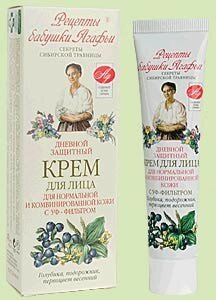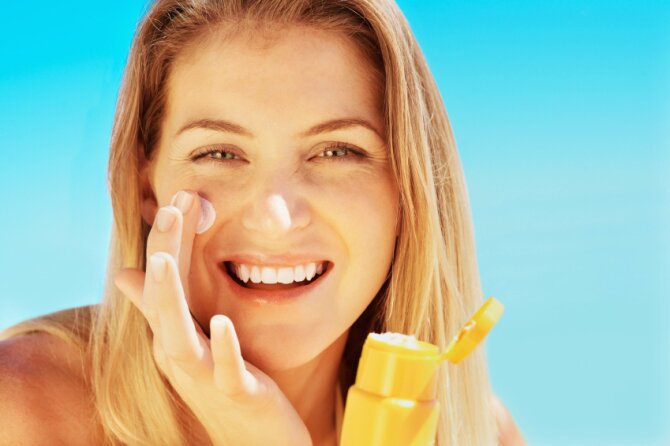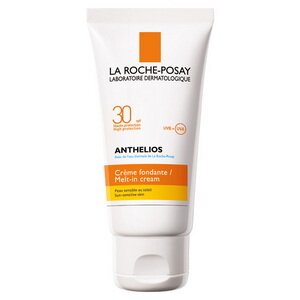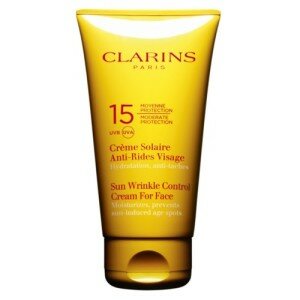Face cream with UV filter
A face cream with a UV filter is a product that helps create a reflective protective layer on the surface of the skin. This barrier scatters UV rays and neutralizes them. UV protection in the cream helps protect the skin from burns and early aging, as well as preserve the functionality and structure of cells. It is necessary to use this product not only while relaxing on the beach, but also in everyday life.
Interesting! Moisturizing day cream with SPF also contains UV filters to protect the epidermis from the sun during the day. Summer face cream should be used daily, especially if you are in the sun for a long time. This cosmetics must be present in your cosmetic bag with the approach of warm spring days.
Types of UV radiation
UV filters are used in many types of cosmetics, including creams, hygiene products, and color cosmetics. The presence of protective components is necessary in order to protect the delicate epithelium from burns and skin diseases resulting from exposure to ultraviolet radiation.
To choose a high-quality and safe product, you need to correctly understand what it should protect our skin from.
There are three types of ultraviolet rays:
- Spectrum C is a short wavelength spectrum that does not reach the Earth's surface. These rays reflect the ozone layer, so spectrum C is safe for us.
- Spectrum B is ultraviolet rays that cause sunburn on the skin. With their prolonged exposure to the epithelium, a burn is formed, so this spectrum is not only useful, but also harmful in case of excessive sunburn. This spectrum does not penetrate light clothing, glass partitions or other barriers. It is very easy to prevent burns in everyday life. To do this, wear light-colored closed clothing and a hat, as well as use sunscreen.
- Spectrum A - rays that are the most dangerous for our epidermis. This spectrum is able to penetrate clothing and also reach the deep layers of the skin. Active rays of ultraviolet A spectrum cause disturbances in the functioning of cells, reduce the elasticity of the skin elasticity fibers, causing aging of the epidermis. In addition, they are able to affect the structure of the DNA of cells, changing their structure and causing cancerous growths. Therefore, filtering from these rays is mandatory on hot summer days. The rays of spectrum A are very insidious: unlike the ultraviolet of spectrum B, they do not cause burns, and their negative harm can manifest itself even after decades.
Important! Creams with UV protection can only reflect spectrum A rays or have a combined composition. A high-quality and reliable product must have a full-fledged protective complex. Keep this in mind when choosing a cream.
Deciphering abbreviations

To choose a good face cream with UV protection, you need to understand what the abbreviations and indices indicated on the bottle mean. All of them indicate the degree of protection from the sun, and their indicator is determined by the coefficient next to the symbols.
Protection indicators and their abbreviation:
- SPF (sun protection factor) - this parameter determines the quality and duration of the sunscreen. The presence of SPF in the cream does not provide full protection from spectrum A rays, since they only determine the additional time spent in the sun. That is, SPF provides protection against redness and burns on the skin. Many manufacturers supplement this factor with other components to provide maximum UV filtering. The coefficient indicated next to this indicator can vary from 5 to 100, which provides a different level of protection from the sun.
- PPD is an indicator that determines protection against spectrum A radiation. The index indicated next to this abbreviation indicates how much the dose of UV radiation is reduced. The maximum PPD value used in cosmetics is 42. It means that the product transmits 42% less UV light.
- IPD is another indicator used in sunscreens. It determines the protective level of the cream against pigmentation and spectrum A rays. The maximum index of this factor is 90%.
- PA is indicative of UV protection, which is used in their products by oriental cosmetic brands. It is defined by "+" signs, which also indicates a protective factor.
Advice! The most effective tool is the one with the abbreviations and. Examine the packaging carefully and check for the presence of various types of filtration.
The composition and action of the cream with a UV filter
An important component of any sunscreen cosmetics is a UV filter. It reduces the effect of ultraviolet radiation on the epidermis, scatters or neutralizes its rays.
The following types of filtration are used as a sun protection factor in cosmetics:
- The chemical filter is a complex of components that penetrate the epidermal barrier and create a protective layer inside the skin. The action of these substances is aimed at absorbing and neutralizing the rays that have penetrated the skin. The old generation filters were not sufficiently improved and very often caused an allergic reaction. New synthetic substances created using safe technologies are significantly different from their predecessors, therefore they are completely safe for people with sensitive skin and children.
- The physical type of filtration is represented by minerals crushed to nanoparticles. As minerals for the physical type of filtration, titanium dioxide and zinc oxide are very often used. These microparticles do not penetrate the epidermis, but create a barrier on its surface that reflects the sun's rays. This type of filtration is very often used in color cosmetics and, of course, in sunscreens with a high level of protection. It is safe for the skin, does not cause irritation and allergies, therefore it can be used as part of. A significant drawback of the physical filter is the appearance of a whitish tint when applied to the skin. However, manufacturers have managed to remove this drawback in modern cosmetics.
- Organic filtration is represented by natural components, which also have reflective properties. Plant extracts, vitamins, antioxidants and oils can increase the effect of the main filters, and also take care of the epidermis. Therefore, almost all sunscreen cosmetics contain additional natural ingredients.
Advice! The most effective are cosmetic products that combine all types of filters. This allows you to create the highest quality and reliable barrier, to prevent not only burns, but also the aging of the epidermis.
Applying UV cream

Use UV creams correctly:
- Choose a product that suits your skin type and phototype. It must contain a sufficient guard index and the necessary filters.
- Apply to skin at least 20 minutes before sun exposure. It is necessary to wait this time so that the chemical filters have time to penetrate the epidermis and form a reliable layer. Physical filters work almost instantly, but even this type of product is recommended to be applied in advance to avoid the appearance of pigmentation during tanning.
- Apply the product as evenly as possible, paying attention to all exposed areas of the face and body. When applied unevenly during exposure to the sun, a difference in protective layers is formed, which ultimately causes an uneven "spotted" tan.
- Use a sufficient amount of the product. Do not save on protection and reduce the portion. Six teaspoons of cream is the minimum required for adult skin.
- Refresh the layer constantly throughout the day. UV protection is constantly weakened by sand, sweat and water, so reapply every two hours. Even waterproof cosmetics do not provide 100% sun protection. Renew the cream after bathing or toweling.
- Apply the cream not only on the body, but also on the face. Use hair products with SPF. Wear hats and light clothing.
- Apply protective cosmetics not only during the holidays, but also in everyday life.
good creams
Day cream with UV filters "Recipes of Grandma Agafia"

- Designed for normal and combination skin types;
- Cares for the epithelium during the day;
- Provides reflection of two spectra of UV radiation;
- Contains blueberries, plantain and spring primrose;
- Inexpensive and economical to use;
- Helps hydrate and nourish the epidermis.
Price: 40 rubles.

- Effective for sun protection;
- Has two levels of filtration;
- Convenient and economical to use;
- Moisturizes and softens the epithelium;
- It has a thick consistency that allows you to apply it evenly.
Price: 700 rubles.
Clarins Anti-Wrinkle Sunscreen SPF 15
![]()
- Reliably protects the skin from two types of UV rays;
- SPF level is 15;
- It is distributed evenly without causing pigmentation;
- Contains caring ingredients;
- Prevents skin aging and wrinkles;
- Prevents burns.
Price: 1 700 rubles.
Conclusion
A face cream with UV filters is a product that provides skin protection from ultraviolet radiation. It helps to prevent the aging of the epidermis and maintain its health. This cosmetics has its own characteristics and provides not only protection, but also skin care.




